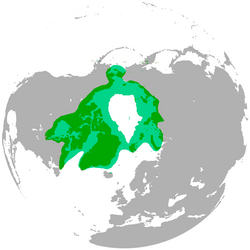Biology:Circumpolar distribution
A circumpolar distribution is any range of a taxon that occurs over a wide range of longitudes but only at high latitudes; such a range therefore extends all the way around either the North Pole or the South Pole.[1][2] Taxa that are also found in isolated high-mountain environments further from the poles are said to have arctic–alpine distributions.[3]
Animals with circumpolar distributions include the reindeer,[1][2] polar bear,[4] Arctic fox,[1][5] snowy owl,[5] snow bunting,[5] king eider,[5] brent goose[5] and long-tailed skua[5] in the north, and the Weddell seal[1] and Adélie penguin[1] in the south.
Plants with northern circumpolar distributions include Eutrema edwardsii (syn. Draba laevigata),[2] Saxifraga oppositifolia,[3] Persicaria vivipara[6] and Honckenya peploides.[7][8][9]
References
- ↑ 1.0 1.1 1.2 1.3 1.4 Vladimir Kotlyakov & Anna Komarova (2006). Elsevier's Dictionary of Geography: in English, Russian, French, Spanish and German. Elsevier. p. 119. ISBN 9780080488783. https://books.google.com/books?id=6DhWw_cYLicC&pg=PA119.
- ↑ 2.0 2.1 2.2 "Circumpolar distribution". Oxford Reference. Oxford University Press. http://www.oxfordreference.com/view/10.1093/oi/authority.20110803095613321. Retrieved November 19, 2014.
- ↑ 3.0 3.1 Peter D. Moore (2009). "Types of tundra". Tundra. Ecosystem Series. Infobase Publishing. pp. 64–85. ISBN 9781438118727. https://books.google.com/books?id=VdA8qT5KZvkC&pg=PA66.
- ↑ T. Kue Young, ed (2011). "Plants and animals". Circumpolar Health Atlas. University of Toronto Press. pp. 21–33. ISBN 978-1-4426-4456-4. https://books.google.com/books?id=AwlYiuPAX-UC&pg=PT31.
- ↑ 5.0 5.1 5.2 5.3 5.4 5.5 Y. I. Chernov (1988). "Distribution of animals and plants". The Living Tundra. Studies in Polar Research. Cambridge University Press. pp. 101–118. ISBN 9780521357548. https://books.google.com/books?id=agc5AAAAIAAJ&pg=PA106.
- ↑ Roger L. Williams (2002). A Guide To Rocky Mountain Plants. Roberts Rinehart. p. 105. ISBN 9781461733492. https://books.google.com/books?id=BVnyAAAAQBAJ&pg=PA105.
- ↑ Julia Sánchez Vilas (2007). Sexual dimorphism in ecological and physiological traits in the subdioecious dune plant Honckenya peploides (L.) Ehrh (Thesis). Universidade de Santiago de Compostela. hdl:10347/2341.
- ↑ Hultén, Eric (1962). The circumpolar plants. 1, Vascular cryptogams, conifers, monocotyledons. Stockholm, Sweden: Almqvist & Wiksell.
- ↑ Hultén, Eric (1971). The circumpolar plants. 2, Dicotyledons. Stockholm, Sweden: Almqvist & Wiksell.
 |


